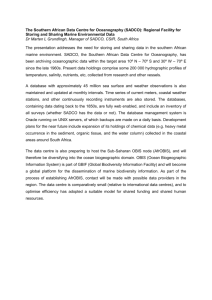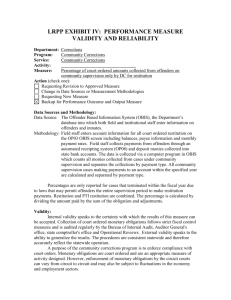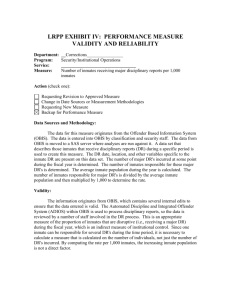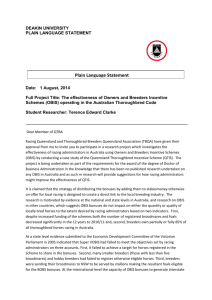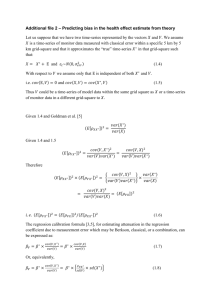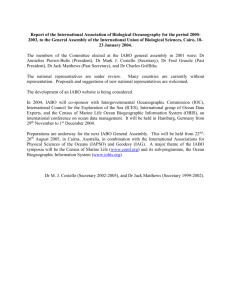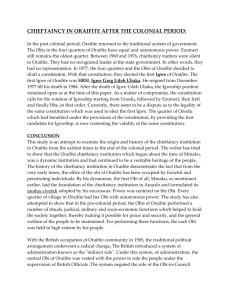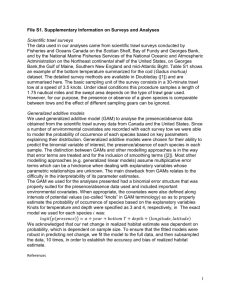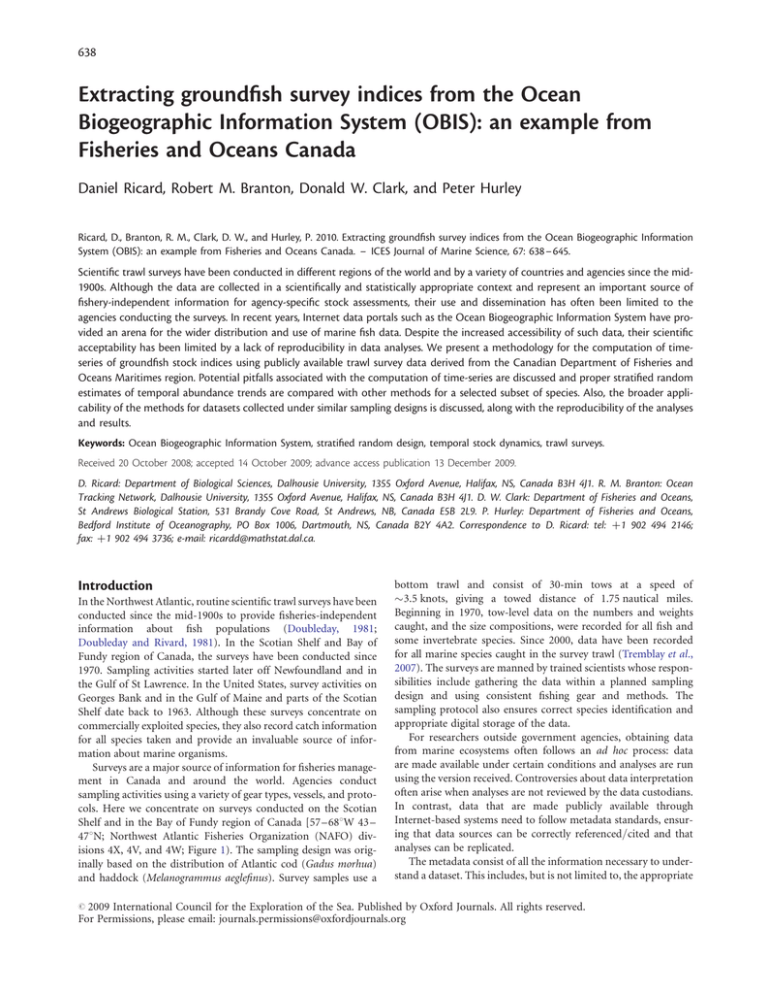
638
Extracting groundfish survey indices from the Ocean
Biogeographic Information System (OBIS): an example from
Fisheries and Oceans Canada
Daniel Ricard, Robert M. Branton, Donald W. Clark, and Peter Hurley
Ricard, D., Branton, R. M., Clark, D. W., and Hurley, P. 2010. Extracting groundfish survey indices from the Ocean Biogeographic Information
System (OBIS): an example from Fisheries and Oceans Canada. – ICES Journal of Marine Science, 67: 638– 645.
Scientific trawl surveys have been conducted in different regions of the world and by a variety of countries and agencies since the mid1900s. Although the data are collected in a scientifically and statistically appropriate context and represent an important source of
fishery-independent information for agency-specific stock assessments, their use and dissemination has often been limited to the
agencies conducting the surveys. In recent years, Internet data portals such as the Ocean Biogeographic Information System have provided an arena for the wider distribution and use of marine fish data. Despite the increased accessibility of such data, their scientific
acceptability has been limited by a lack of reproducibility in data analyses. We present a methodology for the computation of timeseries of groundfish stock indices using publicly available trawl survey data derived from the Canadian Department of Fisheries and
Oceans Maritimes region. Potential pitfalls associated with the computation of time-series are discussed and proper stratified random
estimates of temporal abundance trends are compared with other methods for a selected subset of species. Also, the broader applicability of the methods for datasets collected under similar sampling designs is discussed, along with the reproducibility of the analyses
and results.
Keywords: Ocean Biogeographic Information System, stratified random design, temporal stock dynamics, trawl surveys.
Received 20 October 2008; accepted 14 October 2009; advance access publication 13 December 2009.
D. Ricard: Department of Biological Sciences, Dalhousie University, 1355 Oxford Avenue, Halifax, NS, Canada B3H 4J1. R. M. Branton: Ocean
Tracking Network, Dalhousie University, 1355 Oxford Avenue, Halifax, NS, Canada B3H 4J1. D. W. Clark: Department of Fisheries and Oceans,
St Andrews Biological Station, 531 Brandy Cove Road, St Andrews, NB, Canada E5B 2L9. P. Hurley: Department of Fisheries and Oceans,
Bedford Institute of Oceanography, PO Box 1006, Dartmouth, NS, Canada B2Y 4A2. Correspondence to D. Ricard: tel: þ1 902 494 2146;
fax: þ1 902 494 3736; e-mail: ricardd@mathstat.dal.ca.
Introduction
In the Northwest Atlantic, routine scientific trawl surveys have been
conducted since the mid-1900s to provide fisheries-independent
information about fish populations (Doubleday, 1981;
Doubleday and Rivard, 1981). In the Scotian Shelf and Bay of
Fundy region of Canada, the surveys have been conducted since
1970. Sampling activities started later off Newfoundland and in
the Gulf of St Lawrence. In the United States, survey activities on
Georges Bank and in the Gulf of Maine and parts of the Scotian
Shelf date back to 1963. Although these surveys concentrate on
commercially exploited species, they also record catch information
for all species taken and provide an invaluable source of information about marine organisms.
Surveys are a major source of information for fisheries management in Canada and around the world. Agencies conduct
sampling activities using a variety of gear types, vessels, and protocols. Here we concentrate on surveys conducted on the Scotian
Shelf and in the Bay of Fundy region of Canada [57 –688W 43 –
478N; Northwest Atlantic Fisheries Organization (NAFO) divisions 4X, 4V, and 4W; Figure 1). The sampling design was originally based on the distribution of Atlantic cod (Gadus morhua)
and haddock (Melanogrammus aeglefinus). Survey samples use a
bottom trawl and consist of 30-min tows at a speed of
3.5 knots, giving a towed distance of 1.75 nautical miles.
Beginning in 1970, tow-level data on the numbers and weights
caught, and the size compositions, were recorded for all fish and
some invertebrate species. Since 2000, data have been recorded
for all marine species caught in the survey trawl (Tremblay et al.,
2007). The surveys are manned by trained scientists whose responsibilities include gathering the data within a planned sampling
design and using consistent fishing gear and methods. The
sampling protocol also ensures correct species identification and
appropriate digital storage of the data.
For researchers outside government agencies, obtaining data
from marine ecosystems often follows an ad hoc process: data
are made available under certain conditions and analyses are run
using the version received. Controversies about data interpretation
often arise when analyses are not reviewed by the data custodians.
In contrast, data that are made publicly available through
Internet-based systems need to follow metadata standards, ensuring that data sources can be correctly referenced/cited and that
analyses can be replicated.
The metadata consist of all the information necessary to understand a dataset. This includes, but is not limited to, the appropriate
# 2009 International Council for the Exploration of the Sea. Published by Oxford Journals. All rights reserved.
For Permissions, please email: journals.permissions@oxfordjournals.org
Extracting groundfish survey indices from OBIS
639
Figure 1. The Scotia –Fundy region of the Northwest Atlantic showing NAFO divisions 4X, 4W, and 4V. The solid black polygon shows the
extent of DFO Maritimes’ SUMMER and SUMMER_TELEOST surveys. Fishing tow locations are plotted as tiny grey crosses, and the 200-m
isobath is also shown.
citation of the data, and their spatial and temporal coverage. Good
metadata give credibility to publicly available datasets and foster
proper interpretation of biogeographic data. Several digital standards exist to capture metadata, and being tasked with authoring
them can be daunting; discussion of the merits and pitfalls of the
different metadata standards, however, is beyond the scope of this
paper.
The Internet has changed the way that data are shared and
obtained by researchers, though in fields of marine science such
as physical oceanography, datasets have historically been shared
among scientists. Examples of such datasets include bathymetric
grids, conductivity –temperature – depth (CTD) profiles of the
water column, infrared imagery (sea surface temperature products), and ocean colour imagery (chlorophyll a products). As
such, the computational tools and standards required to store,
query, extract, and analyse the data are mature and available. In
contrast, marine biogeographic datasets such as those derived
from scientific surveys are often held in disparate formats by
various agencies. The standards and tools required to share biogeographic information were only recently formulated, and are
now beginning to gain acceptance within the biogeographic
research community.
Data portals exist that provide access to a wide variety of data
that can be used for scientific analyses of fish population dynamics
and fish diversity. It is hoped that the increasing quantity of
publicly available biogeographic data will foster novel research
initiatives that will utilize the data in a context broader than that
for which they were collected. For example, the Census of
Marine Life’s Ocean Biogeographic Information System (OBIS)
provides access to more than 20 million records from almost
700 different data sources (OBIS, 2009a). The OBIS data portal
provides a centralized location to access data from a multitude
of sources. It also provides visualization tools and the possibility
of downloading data in OBIS schema format. The OBIS schema
format (OBIS, 2009b) is derived from the Darwin Core 2 specification for exchange of information on the geographic occurrence
of living organisms (Taxonomic Diversity Working Group, 2009).
Although the number of records on the OBIS portal is staggering
and making maps of the data is encouraged, it is important for
such systems to go beyond map production. To gain acceptance
in the wider ecological community, data portals need to provide
information that can be used in a broader context, such as the
analysis of temporal and spatial dynamics of marine populations
(Myers, 2000).
Here we describe the steps and methods involved in making the
Department of Fisheries and Oceans (DFO) Maritimes survey data
available on OBIS. This includes creating effective metadata and
generating a properly formatted version of the dataset. We also
demonstrate how the data can be used and misused by comparing
computation methods that generate abundance time-series with
640
various degrees of knowledge on the sampling design of the trawl
surveys. We also discuss the temporal changes observed in the
survey-derived abundance estimates of eight fish species caught
commercially. We show that a naı̈ve interpretation of the publicly
available data yields improper time-series of species abundance,
but that appropriate temporal trends can be computed using
additional information about the sampling design.
The steps detailed here can be applied to other datasets generated in scientific surveys conducted by other fisheries agencies, and
we hope therefore that the methods described to document and
encode survey data collections can and will be repeated. This
will ensure that erroneous interpretations of trawl survey data
are minimized while still promoting wider dissemination of data
through portals such as OBIS.
Methods
The metadata record for the OBIS version of the DFO Maritimes
Research Vessel Trawl Surveys Fish Observations data was created
in Directory Interchange Format (DIF; NASA, 2008) and made
available and discoverable on NASA’s Global Change Master
Directory (GCMD, http://gcmd.nasa.gov/) metadata portal. The
metadata records contained in the GCMD also appear on
Canada’s equivalent metadata discovery site named Geodiscover
(http://geodiscover.cgdi.ca/). These metadata records provide
information about the surveys’ spatio-temporal coverage, and
their citation details, and also provide links to the data available
on the OBIS portal. Additionally, the OBIS portal provides an
extended metadata record containing additional information
about the dataset. The url to both the GCMD and the OBIS metadata records is listed in the References (Clark and Branton, 2007a, b).
To be made accessible to the OBIS portal, the data need to be
formatted to follow the OBIS schema. The groundfish survey
data from DFO Maritimes are stored in a relational database management system at the Bedford Institute of Oceanography in
Dartmouth, NS, Canada. The database contains all information
recorded during the surveys and in subsequent post-survey analyses, such as the age records of fish determined from otoliths.
Using the Structured Query Language (SQL), the data are formatted to follow the OBIS format and made available to the
data portal through a Distributed Generic Information Retrieval
(DiGIR) server, also located at the Bedford Institute of
Oceanography.
For the DFO Maritimes Research Vessel Trawl Surveys Fish
Observations data (Clark and Branton, 2007a), only “valid” tows
are included in the OBIS version. This means that fishing tows
that did not meet the requirements for acceptance (accurate duration and functioning of the gear, not crossing a stratum boundary, etc.) are removed. Additionally, the catch data are
normalized for the distance towed and can be used directly as an
indicator of abundance and biomass. An example OBIS record
from the survey data is provided in Table 1.
The OBIS version of the data used in this paper was obtained in
ASCII format from the OBIS data portal. We used the Advanced
Search facility of the portal to obtain the data from the DFO
Maritimes Research Vessel Trawl Surveys Fish Observations
dataset. The data available from OBIS contain many different
survey series conducted throughout the year with different
vessels and gears. For the current analysis, we concentrated on
the SUMMER and SUMMER_TELEOST survey series, which
consist of data collected during July and August in the Bay
of Fundy and on the Scotian Shelf from 1970 to present. Over
D. Ricard et al.
Table 1. Example of a single OBIS record from the SUMMER
survey of the DFO Maritimes Research Vessel Trawl Surveys Fish
Observations dataset.
Field name
res_name
scientificname
institutioncode
catalognumber
latitude
longitude
collectioncode
datelastmodified
yearcollected
monthcollected
daycollected
minimumdepth
maximumdepth
slatitude
slongitude
elatitude
elongitude
Class
kingdom
ordername
phylum
family
genus
species
scientificnameauthor
collector
fieldnumber
locality
observedindividualcount
observedweight
samplesize
Value
DFOgfsDBfish
Gadus morhua
BIO
TEM2008830-178-10-1
44.34
261.9
SUMMER
2007-07-13T18:24:50Z
2008
7
31
163
164
44.35767
261.90883
44.33
261.89983
Actinopterygii
Animalia
Gadiformes
Chordata
Gadidae
Gadus
morhua
Linnaeus, 1758
TEM
TEM2008830-178
462
1
0.345
1.71 nautical miles41.0 ft
the time frame of available data, the SUMMER and
SUMMER_TELEOST series follow a consistent sampling design.
Additionally, we only include data from stratum 440 to stratum
495, because they are the most consistently sampled over the duration of the survey series.
Before 1982, fishing was carried out with a Yankee 36 otter
trawl, but is now conducted with a Western IIa trawl. There
were also vessel changes during the survey series, CCGS “A.T.
Cameron” being the main survey platform from 1970 to 1981,
CCGS “Lady Hammond” from 1982 to 1991, and CCGS “Alfred
Needler” from 1983 to today. However, for technical reasons,
the CCGS “Alfred Needler” was substituted by its sister ship
CCGS “Wilfred Templeman” in 2008 and by CCGS “Teleost” in
2004 and 2007. For purposes of illustration, abundance time-series
were generated for eight species caught commercially that have
.2000 records in the SUMMER and SUMMER_TELEOST
series of the OBIS dataset (Table 2). These species cover a wide
range of taxa, abundance, and exploitation history, and provide
a base case to evaluate the methods presented here.
Following recommendations made by Branton and Ricard
(2007), individual tows i in the OBIS version of the DFO dataset
can be identified by the value in the fieldnumber field of the
OBIS schema. Similarly, stratum s is identified by the locality
field, the swept-area of the trawlnet by the samplesize field, and
the vessel by the collector field. The OBIS version of the dataset
consists of observations only, and all sampling locations (including
641
Extracting groundfish survey indices from OBIS
Table 2. Species used in the analysis and the number of records
from the SUMMER and SUMMER_TELEOST survey data (for
stratum 440 to stratum 495) available in the OBIS dataset.
Common name
American plaice
Atlantic cod
Haddock
Silver hake
Redfish species
White hake
Herring
Pollock
Scientific name
Hippoglossoides platessoides
Gadus morhua
Melanogrammus aeglefinus
Merluccius bilinearis
Sebastes spp.
Urophycis tenuis
Clupea harengus
Pollachius virens
Number of
records in OBIS
5 049
4 613
4 373
3 470
3 108
2 790
2 262
2 143
those where a species is not caught) need to be used to determine
observations of zero catch. We assigned values of zero catch to
tows where a species was not observed. For each combination of
year y, stratum s, and tow i, we used the OBIS data to create
observations of fish abundance for the eight species of interest.
Each abundance observation is either the value observed in the
“observedindividualcount” field of the OBIS data record, or zero
if a tow did not have a catch record for a given species. In
other words, for each species we generated observations a0y;s;i .
For illustration purposes, we also created catch records ay,s,i that
included only the observations and that did not account for
records of zero catch.
Using the two types of record generated from the OBIS data
(a0y;s;i and ay,s,i), we used four computation methods to generate
annual time-series that corresponded to varying degrees of understanding about the dataset. The methods rely on the assumptions
made about the data and how they were collected. The different
computations presented below range from naı̈ve interpretations
of the data to appropriate estimation of catch rates with knowledge
of the sampling design.
The first method does not take into account the stratification
scheme of the survey and also does not take the zeroes into
account. The annual estimate of population abundance for each
species is calculated as the mean abundance for that year, excluding the zero observations. We refer to this time-series as OBIS raw:
PS Pny;s
a^ y ¼
s¼1
i¼1
ay;s;i
ny
;
ð1Þ
where ny,s is the number of catch records from the OBIS dataset in
year y and
P stratum s, ny the total number of catch records in year y
ðny ¼ Ss¼1 ny;s Þ, and S the number of strata sampled in year y.
This method can result in overestimation of abundance,
because samples with zero catch are not included in the calculations. The annual estimates for the second method take the
zeroes into account. We refer to this time-series as OBIS with
zeroes:
PS Pn0y;s
a^ 0y
¼
s¼1
i¼1
n0y
a0y;s;i
;
Equation (2) still does not account appropriately for the sampling
design, because it assumes that each sample was independent.
To attempt to account for the stratum and year effects, a third
time-series was generated using a generalized linear model (GLM)
with negative binomial error and a log link using strata (s) and year
(y) as factors. In other words, population abundance
Pn0y;s 0
a0y;s ¼ i¼1
ay;s;i is assumed to follow a negative binomial distribution of mean m, and the linear predictor (LP) of m is
logðmy;s Þ ¼ LPy;s ¼ a þ by þ gs ;
where a is the overall mean, by the year effect, subject to
PY
PS
y¼1 by ¼ 0, and gs is the strata effect, subject to
s¼1 gs ¼ 0.
The fitted model was then used to predict an annual time-series
that we refer to here as OBIS GLM.
Finally, the fourth time-series was generated by computing the
annual stratified random estimates of species abundance using
strata statistics obtained from the OBIS Canada site (OBIS
Canada, 2009). These statistics are required for computation of
stratified random estimates of abundance. The additional information required consisted of the surface area of each stratum s,
which was divided by the swept-area of the gear to obtain the
number of towable units in each stratum (Ns). The data from
OBIS were used to compute annual estimates of fish abundance
for the different species of interest. Following the methods documented in Smith (1996) and Lohr (1999), we computed the stratified mean for each year and refer to the time-series as OBIS
stratified:
a y ¼
S
X
Ns
s¼1
N
a y;s ;
ð4Þ
where s ¼ 1, 2, 3, . . . , S are the different strata, a y;s the catch
Pn0y;s 0
ay;s;i Þ; Ns the
sample mean for stratum s in year y ðay;s ¼ i¼1
P
number of towable units in stratum s, and N ¼ Ss¼1 Ns the
total number of towable units in the area surveyed.
Although useful, time-series of population abundance need to
be interpreted carefully, and the uncertainty associated with the
estimates needs to be provided. This can be done readily using
the OBIS data. Following from Equation (4), the estimated stratified variance for each year can be calculated from
^ ay Þ ¼
Vð
S X
1
s¼1
ns
Ns
Ns
N
2 ns
;
ns
ð5Þ
where ns is the number of tows in stratum s, and ns the catch
sample variance for stratum s.
It is common to report the standard error of an estimator,
which is the square root of the estimated variance. In our case,
the standard error (s.e.) is
ð2Þ
where n0y;s is the number of catch records from the OBIS dataset in
year y and stratum s, including catches with zero individuals, and
n0y the total number of catch
Precords, including catches with zero
individuals, in year y ðn0y ¼ Ss¼1 n0y;s Þ. Note that, while accounting
for observations of zero catch, the time-series generated from
ð3Þ
s.e.ðay Þ ¼
qffiffiffiffiffiffiffiffiffiffiffi
^ ay Þ:
Vð
ð6Þ
The four time-series generated from the publicly available data
(OBIS raw, OBIS with zeroes, OBIS GLM, and OBIS stratified)
were compared with each other to identify differences in interpretation associated with each methodology. The stratified random
642
D. Ricard et al.
Figure 2. Abundance time-series for (a) redfish (Sebastes spp.), (b) Atlantic herring (C. harengus), (c) silver hake (Merluccius bilinearis), (d)
haddock (M. aeglefinus), (e) Atlantic cod (G. morhua), (f) American plaice (H. platessoides), (g) pollock (P. virens), and (h) white hake
(Urophycis tenuis) obtained using the OBIS version of the DFO’s SUMMER and SUMMER_TELEOST survey data from 1970 to 2009 in the
Scotia– Fundy region of the Northwest Atlantic (NAFO divisions 4X and 4VsW). The heavy black line is the OBIS stratified reference
time-series, the dashed line the OBIS raw time-series, the dotted line the OBIS with zeroes time-series, and the grey line the OBIS GLM
time-series.
estimate of abundance was used as the reference case because it
accurately accounted for the survey design (Smith, 1996). We
were interested in seeing how well the different methods estimated
the abundance trends of the eight species of interest.
For comparing the different methodologies used to derive the
time-series, we reported Spearman’s and Pearson’s correlation
coefficients between the reference case (OBIS stratified) and
OBIS raw, OBIS with zeroes, and OBIS GLM. These measures of
standard correlation provide an indication of the association
between a computation method and the reference case, but they
do not account for systematic differences. If two methods are identical in their measurement properties, we would expect them to
follow a linear relationship of unit slope and zero intercept. The
intraclass correlation coefficient, ICC(1,1), as defined in Shrout
and Fleiss (1979), measures deviations from the unit slope and
zero intercept (an ICC value of near 1 would indicate values
that fall close to this ideal).
All data handling was carried out using a PostgreSQL relational
database management system (PostgreSQL Global Development
Group, 2009). Statistical analyses and generation of plots were
conducted with the R Environment for Statistics and Graphics
(R Development Core Team, 2009) using the packages beanplot
(Kampstra, 2008), irr (Gamer et al., 2007), MASS (Venables and
Ripley, 2002), and RODBC (Ripley and Lapsley, 2009). The map
in Figure 1 was generated using the Generic Mapping Tools
(Wessel and Smith, 1991).
Results
The four abundance time-series generated using the OBIS data
plotted for the eight species of interest are presented in Figure 2.
The stratified random estimate of the number of fish per tow in
a given year ranged from a maximum of 571.07 per tow for
redfish species (Sebastes spp.; Figure 2a) in 2009 to a minimum
of 0.13 fish per tow for herring (Clupea harengus; Figure 2b) in
1978. Species such as pollock (Pollachius virens; Figure 2g)
showed a high variability in annual estimates. Other species,
such as haddock (M. aeglefinus; Figure 2d) and redfish, showed
an increasing trend in abundance over the time-series.
For the eight species of interest, the Spearman’s correlation
coefficients, Pearson’s correlation coefficients, and intraclass correlation coefficients, ICC(1,1), between the three methods used
with the OBIS data and the reference methodology (OBIS stratified) are listed in Table 3. In general, the ICC value was lower
than that of either the Spearman’s or Pearson’s coefficients, indicating that although the time-series were highly correlated, there
were discrepancies between the reference case and the other
methods.
An example of the standard error being added to the timeseries, to provide an estimate of the uncertainty associated with
the stratified random mean for Atlantic cod (G. morhua), is
given in Figure 3.
Discussion
The GCMD and Geodiscover websites provide access to the metadata record for the DFO Maritimes Research Vessel Trawl Surveys
Fish Observations. The clear documentation of the dataset
through a proper metadata record provides authority and citability
to the data. However, the DIF format used by GCMD is limited in
its ability to describe the details associated with the data collection
in full. An alternative metadata standard that can be used is the
Ecological Metadata Language (EML; EML Project, 2008), and
we hope to provide the DFO Maritimes Research Vessel Trawl
Surveys Fish Observations as an EML record in future.
643
Extracting groundfish survey indices from OBIS
Each computation method includes a different degree of
understanding of the data collection, which is reflected in how
well the results compare with the reference method. In general,
the OBIS raw method yielded the least agreement with the reference case. ICC values were lower than either Spearman’s or
Table 3. Value of correlation coefficients between the reference
time-series and the other OBIS-derived time-series.
Species
Hippoglossoides
platessoides
Gadus morhua
Melanogrammus
aeglefinus
Merluccius bilinearis
Sebastes spp.
Urophycis tenuis
Clupea harengus
Pollachius virens
Correlation
measure
Spearman
Pearson
ICC(1,1)
Spearman
Pearson
ICC(1,1)
Spearman
Pearson
ICC(1,1)
Spearman
Pearson
ICC(1,1)
Spearman
Pearson
ICC(1,1)
Spearman
Pearson
ICC(1,1)
Spearman
Pearson
ICC(1,1)
Spearman
Pearson
ICC(1,1)
OBIS
raw
0.768
0.808
0.531
0.866
0.899
0.618
0.908
0.956
0.290
0.957
0.954
0.617
0.917
0.890
0.369
0.899
0.886
0.062
0.936
0.921
0.636
0.853
0.842
0.197
OBIS
with
zeroes
0.823
0.841
0.627
0.942
0.922
0.877
0.957
0.979
0.815
0.979
0.954
0.917
0.931
0.934
0.935
0.881
0.863
0.847
0.991
0.982
0.976
0.917
0.888
0.867
OBIS
GLM
0.583
0.624
0.089
0.910
0.930
0.885
0.872
0.708
0.644
0.908
0.859
0.777
0.520
0.587
0.453
0.671
0.705
0.628
0.971
0.955
0.814
0.745
0.616
0.457
Pearson’s correlation coefficients, indicating that methods that
seem to do a good job at estimating annual abundance are in
reality rather poor. Because it takes the sampling design into
account, the stratified random methodology is the most appropriate estimator of yearly abundance.
The OBIS raw time-series tended to overestimate the average
number of fish caught per tow for most years and most species,
likely because the computed annual average does not include
observations of zero catch. As a large proportion of the tows
have zero catch (Figure 4), it is important to account for zeroes
in the computation of the time-series. Note, however, that the
OBIS raw time-series sometimes provided annual estimates less
than the stratified random estimates (e.g. 1971, 1972, and 1980
for American plaice, Hippoglossoides platessoides; Figure 2f).
Using raw annual averages from the OBIS data is, however,
wrong, so the time-series derived should not be used for analysing
trends in population abundance, especially when combining data
from different sources (as was unfortunately done by NOAA,
2005a).
The OBIS with zeroes time-series more closely matched the
reference time-series than the OBIS raw time-series but still did
not account for the sampling design. For species with a large proportion of tows of zero catch (Figure 4), accounting for the zeroes
provided time-series estimates that more closely matched the
reference time-series but still did not account for the sampling
design.
The OBIS GLM time-series was generated from a fitted model
that aimed to account for stratum and year effects, estimating a
parameter for each year and each stratum. However, the model
assumes that the strata effects are the same over the whole timeseries and that the year effects are the same over all strata. As the
GLM uses a log link and a negative binomial error distribution
it treats catches of zero differently from the other methods and
also reduces the effects that large catches have on the overall
annual estimate.
Figure 3. Abundance time-series for Atlantic cod obtained using the OBIS version of the DFO’s SUMMER and SUMMER_TELEOST survey
data from 1970 to 2009 in the Scotia –Fundy region of the Northwest Atlantic (NAFO divisions 4X and 4VsW), including an estimate of the
uncertainty of the annual estimate of stratified random mean abundance. The mean annual estimate is plotted as a solid line along with +1
s.e. (dotted lines).
644
Figure 4. Proportion of tows with zero catch for the eight species of
interest. The proportion of tows with zero catch is computed for
each species and each year in the survey data (n ¼ 40 for each
species) and presented as a beanplot, showing the proportion of
tows with zero catch for each year (thin vertical white lines) and the
mean proportion of tows with zero catch (thick vertical black line).
The dotted vertical line represents 50% of tows with zero catch.
The number of records in the OBIS datasets is a reflection of
how common a species is in the survey samples. Although a
species may be taken frequently, its real abundance in the
samples may be less than that of species that are taken less often.
This is the case for American plaice, the species with the most
records in the OBIS record but with values of annual abundance
far less than those of other species (Figure 2).
Agencies conducting similar surveys to those conducted by
DFO Maritimes should consider making their data available on
OBIS. An essential step in making data available on OBIS is to
provide authoritative metadata. Additionally, using interpretations of OBIS fields similar to those used here will facilitate the
wider use of groundfish survey datasets by researchers. Trawl
survey scientific data from the US Northeast Fisheries Science
Center were recently made available on OBIS (NOAA, 2005b),
and they use similar encodings to DFO Maritimes data.
Although they provide crucial baseline information about a
particular area, trawl surveys still have limited spatio-temporal
coverage. Although combining survey time-series poses many
challenges, doing so can augment knowledge of the spatiotemporal dynamics at scales that exceed those of individual
surveys. As the different time-series computed from the OBIS
data show, it is important to incorporate the sampling design
into computations of abundance time-series.
To interpret correctly how trawl survey data relate to fish population dynamics, it is also important to consider seasonal
migrations and other spatial shifts in the distribution of species
during the time-series available. As such, the estimates derived
from the survey data are just a starting point for further analysis
of fish population dynamics. A stock assessment will also use
data on landings and other sources of information about the
species. The range of a species may also be limited to a subset of
the strata, and assessment scientists need to use this knowledge
to generate realistic time-series of abundance and biomass over
the survey area. The methodology presented here can be used
D. Ricard et al.
also to compute stratified random estimates over a subset of
strata in the surveyed area.
We are aware that the time-series we computed provide only a
measure of the number of fish caught per tow and not an estimate
of total abundance over the area surveyed. Knowledge of the
catchability of the fish species to the gear is also necessary in computing a value of total abundance. We only considered species
abundance, but the OBIS data also contain biomass data for the
surveys (stored in the “observedindividualweight” field of each
OBIS record). As such, estimates of population biomass can also
be computed using publicly available data.
The methods used to generate the OBIS version of the DFO
Maritimes Research Vessel Trawl Surveys Fish Observations also
mean that once the results of a survey have been uploaded into
the production database, new data can be quickly updated in the
public domain. In other words, additional catch records added
to the OBIS version of a dataset are soon available for use. The
data available on OBIS can also be used to conduct analyses of
the diversity of fish species. The sampling protocols for fish
species are consistent for the duration of the surveys, but care is
necessary in accounting for the catchability of different fish
species. Nevertheless, a dataset similar to that provided on OBIS
has been used successfully to examine changes in fish diversity
in the surveyed area (Shackell and Frank, 2003).
One of the many limitations of the OBIS data format is that it is
not well suited for life-history analyses. For example, analyses of
growth rate, maturation schedules, and age-specific fecundity
cannot be performed using the data available on OBIS.
However, such data are usually easily available from the data custodians identified in the OBIS metadata record, making the data
discoverable and authoritative and providing a vehicle for wider
dissemination of scientific trawl survey data.
Acknowledgements
We thank the officers and crews of Canadian Coast Guard vessels
for their assistance during and efforts to complete scientific trawl
surveys. We are also grateful to Lenore Bajona and Bette Hatt of
DFO for help in updating the publicly available dataset and metadata records presented here, and the late Ransom Myers for his
ideas and enthusiasm in developing a general framework for
sharing scientific trawl survey data. Coilı́n Minto made useful
comments on an earlier version of this manuscript, Wade
Blanchard and Stephen Smith gave statistical advice, and three
anonymous reviewers provided constructive comments which
greatly improved the quality of this document.
References
Branton, R. M., and Ricard, D. 2007. Developing OBIS into a tool to
provide reliable estimates of population indices for marine species
from research trawl surveys. In Proceedings of “Ocean Biodiversity
Informatics”: an International Conference on Marine Biodiversity
Data Management, pp. 19 – 24. Ed. by E. vanden Berghe, W.
Appeltans, M. Costello, and P. Pissierssens. UNESCO/IOC,
Vlaams Instituut voor de Zee (VLIZ), Bundesamt für
Seeschifffahrt und Hydrographie (BSH). 192 pp.
Clark, D., and Branton, B. 2007a. DFO Maritimes Research Vessel
Trawl Surveys. In OBIS Canada Digital Collections, version 1,
Digital. OBIS Canada, Bedford Institute of Oceanography,
Dartmouth, Nova Scotia, Canada. http://gcmd.nasa.gov/
KeywordSearch/Metadata.do?Portal=OBIS&OrigMetadataNode=
GCMD&EntryId=OBIS.DFOgfsDBfish&MetadataView=Full&
lbnode=mdlb2 (last accessed 30 August 2009).
Extracting groundfish survey indices from OBIS
Clark, D., and Branton, B. 2007b. DFO Maritimes Research Vessel
Trawl Surveys. In OBIS Canada Digital Collections, version 1,
Digital. OBIS Canada, Bedford Institute of Oceanography,
Dartmouth, Nova Scotia, Canada. http://www.iobis.org/
OBISWEB/DisplayMetaData.jsp?content=meta/237.html
(last
accessed 30 August 2009).
Doubleday, W. G. 1981. Manual on groundfish surveys in the
Northwest Atlantic. NAFO Scientific Council Studies, 2. 56 pp.
Doubleday, W. G., and Rivard, D. 1981. Bottom trawl surveys.
Canadian Special Publication of Fisheries and Aquatic Sciences,
58. 273 pp.
EML Project. 2008. Ecological Metadata Language, version 2.0.1.
http://knb.ecoinformatics.org/software/eml/ (last accessed 30
August 2009).
Gamer, M., Lemon, J., and Fellows, I. 2007. irr: Various Coefficients
of Interrater Reliability and Agreement. R Package, version 0.70.
http://www.r-project.org (last accessed 30 August 2009).
Kampstra, P. 2008. Beanplot: a boxplot alternative for visual comparison of distributions. Journal of Statistical Software, Code Snippets,
28: 1– 9.
Lohr, S. L. 1999. Sampling: Design and Analysis. Duxbury Press,
Pacific Grove, CA. 450 pp.
Myers, R. A. 2000. The synthesis of dynamic and historical data on
marine populations and communities; putting dynamics into the
Ocean
Biogeographical
Information
System
(OBIS).
Oceanography, 13: 56 – 59.
NASA (National Aeronautics and Space Administration). 2008.
Directory Interchange Format (DIF) Writer’s Guide. http://gcmd.
nasa.gov/User/difguide/DFI_Guide_2008.pdf (last accessed 30
August 2009).
NOAA. 2005a. Species of concern fact sheet. http://www.nmfs.noaa.
gov/pr/pdfs/species/riverherring_detailed.pdf (last accessed 30
August 2009).
NOAA. 2005b. Northeast Fisheries Science Center bottom trawl survey
data. NOAA National Marine Fisheries Service (NMFS) Northeast
Fisheries Science Center, Ecosystems Survey Branch, Woods Hole,
MA, 2005-04-30, Tabular Digital Data. http://www.iobis.org/
OBISWEB/DisplayMetaData.jsp?content=meta/1435.html (last
accessed 30 August 2009).
645
OBIS. 2009a. Ocean Biogeographic Information System. http://www.
iobis.org (last accessed 30 August 2009).
OBIS. 2009b. The OBIS Schema, version 1.1. http://iobis.org/tech/
provider/schemadef1.html (last accessed 30 August 2009).
OBIS Canada. 2009. Ocean Biogeographic Information System—
Canadian Regional OBIS Node. DFO Maritimes survey strata statistics. http://www.marinebiodiversity.ca/OBISCanada/etc/dfomaritimes-survey-strata-statistics (last accessed 30 August 2009).
PostgreSQL Global Development Group. 2009. PostgreSQL, version
8.3.8. http://www.postgresql.org (last accessed 30 August 2009).
R Development Core Team. 2009. R: a Language and Environment for
Statistical Computing. R Foundation for Statistical Computing,
Vienna, Austria.
Ripley, R., and Lapsley, M. 2009. RODBC: ODBC Database Access. R
package
version
1.3-0.
http://CRAN.R-project.org/
package=RODBC (last accessed 30 August 2009).
Shackell, N., and Frank, K. T. 2003. Marine fish diversity on the
Scotian Shelf, Canada. Aquatic Conservation: Marine and
Freshwater Ecosystems, 13: 305– 321.
Shrout, P. E., and Fleiss, J. L. 1979. Intraclass correlations: uses in
assessing rater reliability. Psychological Bulletin, 2: 420 – 428.
Smith, S. J. 1996. Assessment of groundfish stocks based on bottom
trawl survey results. NAFO Scientific Council Studies, 28: 25– 53.
Taxonomic Diversity Working Group. 2009. Darwin Core. http://rs
.tdwg.org/dwc/index.htm (last accessed 30 August 2009).
Tremblay, M., Black, G., and Branton, R. 2007. The distribution of
common decapod crustaceans and other invertebrates recorded
in annual ecosystem surveys of the Scotian shelf 1999 – 2006.
Canadian Technical Report of Fisheries and Aquatic Sciences,
2762. iii þ 74 pp.
Venables, W. N., and Ripley, B. D. 2002. Modern Applied Statistics
with S, 4th edn. Springer, New York.
Wessel, P., and Smith, W. H. F. 1991. Free software helps map and
display data. EOS Transactions of the American Geophysical
Union, 72: 441.
doi:10.1093/icesjms/fsp275

